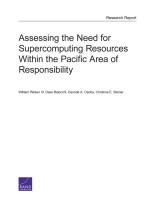| 来源类型 | Research Reports
|
| 规范类型 | 报告
|
| DOI | https://doi.org/10.7249/RR1427
|
| ISBN | 9780833094278
|
| 来源ID | RR-1427-AF
|
| Assessing the Need for Supercomputing Resources Within the Pacific Area of Responsibility |
| William Welser IV; Dave Baiocchi; Osonde A. Osoba; Christina E. Steiner
|
| 发表日期 | 2017
|
| 出版年 | 2017
|
| 页码 | 50
|
| 语种 | 英语
|
| 结论 |
- There is a consistent lack of understanding among the customer base as to what problems are suitable for a supercomputer or high performance computing assets, in general.
- While several entities within PACOM offered a stated preference for a supercomputing facility within the geographic region, we were unable to identify any entity within the Pacific AOR with a quantitative requirement for real time supercomputing. In the absence of such a requirement, we did gather anecdotal evidence for the value that PACOM users receive by having HPC expertise located within the AOR.
- PACOM users value MHPCC's ability to stand up and support custom servers. These users also value MHPCC's resident expertise in programming for high performance computing architectures.
- MHPCC and AFRL's Maui optical observatory both benefit from being co-located.
|
| 摘要 |
- Be explicit about the different capabilities at MHPCC. Potential users need to be aware of what MHPCC has to offer, what is available from other entities within the HPCMP enterprise, and, if appropriate, what other services are available outside the HPCMP.
- MHPCC should market itself as offering three separate products: a 12,096-node supercomputer; a facility with the expertise and infrastructure to host standalone HPC assets; and a research staff with the capacity to develop creative solutions to operational problems. Presenting MHPCC as a center that offers separate products will allow for a more-tailored approach to solving customer problems.
- Provide PACOM users with a framework for matching HPC assets to the desired workflow. HPC is inherently technical, and PACOM customers need simple frameworks to understand how their problem fits into the greater context.
- Employ strategic and technical thought leaders to enhance Pacific AOR customer exploitation of MHPCC capabilities. Strategists need to identify areas where Pacific AOR users might benefit from HPC capabilities, and the strategists need to work with the subject-matter experts to help them develop future requirements for HPC assets.
- Rebuild trust and understanding with the HPCMP leadership. Reestablishing trust always takes time, but MHPCC management can take some initial steps by setting up consistent communication with HPCMP leadership.
- Recognize that aspects of the computing enterprise are changing. As computing cycles become more of a commodity, it will be important to develop a value proposition that focuses more on MHPCC's human capital and is not tied to hardware alone.
|
| 主题 | Hawaii
; Military Budgets and Defense Spending
; Military Information Technology Systems
; United States Air Force
; United States Army
; United States Department of Defense
|
| URL | https://www.rand.org/pubs/research_reports/RR1427.html
|
| 来源智库 | RAND Corporation (United States)
|
| 引用统计 |
|
| 资源类型 | 智库出版物
|
| 条目标识符 | http://119.78.100.153/handle/2XGU8XDN/108493
|
推荐引用方式
GB/T 7714 |
William Welser IV,Dave Baiocchi,Osonde A. Osoba,et al. Assessing the Need for Supercomputing Resources Within the Pacific Area of Responsibility. 2017.
|
|
文件名:
|
x1495316289557.jpg
|
|
格式:
|
JPEG
|

|
文件名:
|
RAND_RR1427.pdf
|
|
格式:
|
Adobe PDF
|
除非特别说明,本系统中所有内容都受版权保护,并保留所有权利。